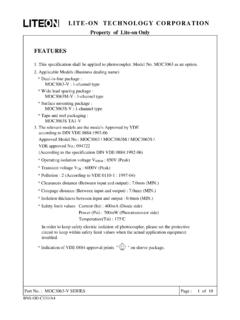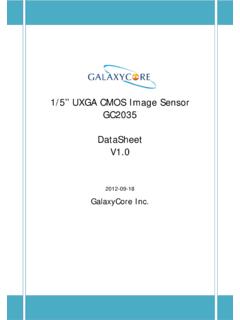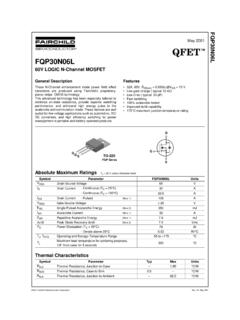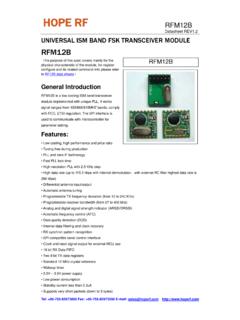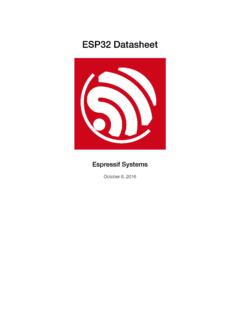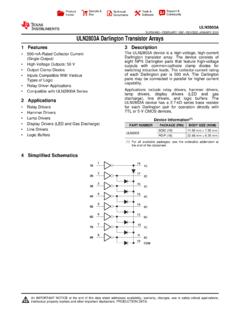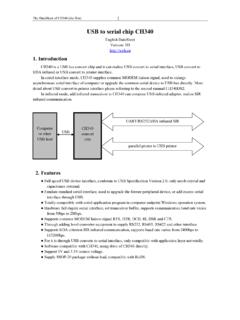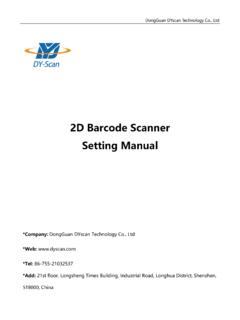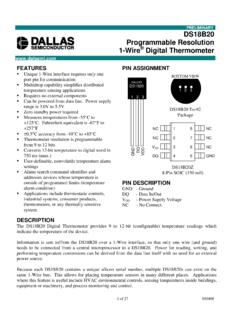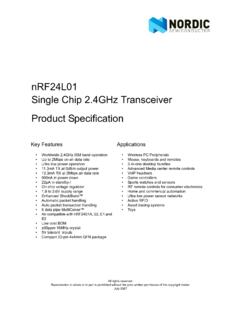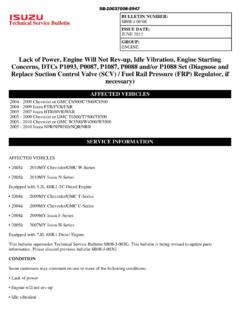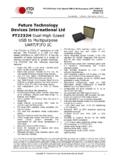Transcription of W5500 Datasheet - SparkFun Electronics
1 Copyright 2013 WIZnet Co., Ltd. All rights reserved. W5500 Datasheet Version 2 / 66 W5500 Datasheet (November 2013) W5500 The W5500 chip is a Hardwired TCP/IP embedded Ethernet controller that provides easier Internet connection to embedded systems. W5500 enables users to have the Internet connectivity in their applications just by using the single chip in which TCP/IP stack, 10/100 Ethernet MAC and PHY embedded. WIZnet s Hardwired TCP/IP is the market-proven technology that supports TCP, UDP, IPv4, ICMP, ARP, IGMP, and PPPoE protocols. W5500 embeds the 32 Kbyte internal memory buffer for the Ethernet packet processing. If you use W5500 , you can implement the Ethernet application just by adding the simple socket program. It s faster and easier way rather than using any other Embedded Ethernet solution. Users can use 8 independent hardware sockets simultaneously. SPI (Serial Peripheral Interface) is provided for easy integration with the external MCU.
2 The W5500 s SPI supports 80 MHz speed and new efficient SPI protocol for the high speed network communication. In order to reduce power consumption of the system, W5500 provides WOL (Wake on LAN) and power down mode. Features - Supports Hardwired TCP/IP Protocols : TCP, UDP, ICMP, IPv4, ARP, IGMP, PPPoE - Supports 8 independent sockets simultaneously - Supports Power down mode - Supports Wake on LAN over UDP - Supports High Speed Serial Peripheral Interface(SPI MODE 0, 3) - Internal 32 Kbytes Memory for TX/RX Buffers - 10 BaseT/100 BaseTX Ethernet PHY embedded - Supports Auto Negotiation (Full and half duplex, 10 and 100-based ) - Not supports IP Fragmentation - operation with 5V I/O signal tolerance - LED outputs (Full/Half duplex, Link, Speed, Active) - 48 Pin LQFP Lead-Free Package (7x7mm, pitch) W5500 Datasheet (November 2013) 3 / 66 Target Applications W5500 is suitable for the following embedded applications: - Home Network Devices: Set-Top Boxes, PVRs, Digital Media Adapters - Serial-to-Ethernet: Access Controls, LED displays, Wireless AP relays, etc.
3 - Parallel-to-Ethernet: POS / Mini Printers, Copiers - USB-to-Ethernet: Storage Devices, Network Printers - GPIO-to-Ethernet: Home Network Sensors - Security Systems: DVRs, Network Cameras, Kiosks - Factory and Building Automations - Medical Monitoring Equipment - Embedded Servers 4 / 66 W5500 Datasheet (November 2013) Block Diagram W5500 Datasheet (November 2013) 5 / 66 Table of Contents Pin Assignment .. 7 Pin Descriptions .. 7 HOST Interface .. 12 SPI Operation Mode .. 13 SPI Frame .. 14 Address 14 Control Phase .. 15 Data Phase .. 17 Variable Length Data Mode (VDM) .. 17 Write Access in VDM .. 18 Read Access in VDM .. 21 Fixed Length Data Mode (FDM) .. 24 Write Access in FDM .. 25 Read Access in FDM .. 26 Register and Memory Organization .. 27 Common Register Block .. 29 Socket Register Block .. 30 Memory .. 31 Register Descriptions .. 32 Common Registers .. 32 Socket Registers .. 44 Electrical Specifications.
4 59 Absolute Maximum Ratings .. 59 Absolute Maximum Ratings (Electrical Sensitivity) .. 59 DC Characteristics .. 60 POWER DISSIPATION .. 61 AC Characteristics .. 61 Reset Timing .. 61 Wake up Time .. 61 Crystal Characteristics .. 61 SPI Timing .. 62 Transformer Characteristics .. 63 MDIX .. 63 Package Descriptions .. 64 6 Document History Information .. 65 6 / 66 W5500 Datasheet (November 2013) Table of Figures Figure 1. W5500 Pin Layout .. 7 Figure 2. External reference resistor .. 11 Figure 3. Crystal reference schematic .. 11 Figure 4. Variable Length Data Mode (SCSn controlled by the host) .. 12 Figure 5. Fixed Length Data Mode (SCSn is always connected by Ground) .. 12 Figure 6. SPI Mode 0 & 3 .. 13 Figure 7. SPI Frame Format .. 14 Figure 8. Write SPI Frame in VDM mode .. 18 Figure 9. SIMR Register Write in VDM Mode .. 19 Figure 10. 5 Byte Data Write at 1th Socket s TX Buffer Block 0x0040 in VDM mode .. 20 Figure 11.
5 Read SPI Frame in VDM mode .. 21 Figure 12. S7_SR Read in VDM Mode .. 22 Figure 13. 5 Byte Data Read at Socket 3 RX Buffer Block 0x0100 in VDM mode .. 23 Figure 14. 1 Byte Data Write SPI Frame in FDM 25 Figure 15. 2 Bytes Data Write SPI Frame in FDM mode .. 25 Figure 16. 4 Bytes Data Write SPI Frame in FDM mode .. 25 Figure 17. 1 Byte Data Read SPI Frame in FDM mode .. 26 Figure 18. 2 Bytes Data Read SPI Frame in FDM mode .. 26 Figure 19. 4 Bytes Data Read SPI Frame in FDM mode .. 26 Figure 20. Register & Memory Organization .. 28 Figure 21. INTLEVEL Timing .. 34 Figure 22. Reset Timing .. 61 Figure 23. SPI Timing .. 62 Figure 24. Transformer Type .. 63 Figure 25. Package Dimensions .. 64 W5500 Datasheet (November 2013) 7 / 66 Pin Assignment 1 Figure 1. W5500 Pin Layout Pin Descriptions Table 1. Pin Type Notation Type Description I Input O Output I/O Input / Output A Analog PWR power GND Ground TXNTXPAGNDAVDDRXNRXPDNCAVDDAGNDEXRES1 AVDDNC1234567891011123635343332313029282 72625W5500 NCAGNDAVDDAGNDAVDDVBGAGNDTOCAPAVDD1V2 ORSVDSPDLEDMOSIMISOSCLKSCSnXOXI/CLKINGND VDDACTLEDDUPLEDLINKLEDINTnAGNDNCNCPMODE0 PMODE1 PMODE2 RSVDRSVDRSVDRSVDRSVDRSTn1314151617181920 2122232448474645444342414039383748 LQFP 8 / 66 W5500 Datasheet (November 2013) Table 2.
6 W5500 Pin Description Pin No Symbol Internal Bias1 Type Description 1 TXN - AO TXP/TXN Signal Pair The differential data is transmitted to the media on the TXP/TXN signal pair. 2 TXP - AO 3 AGND - GND Analog ground 4 AVDD - PWR Analog power 5 RXN - AI RXP/RXN Signal Pair The differential data from the media is received on the RXP/RXN signal pair. 6 RXP - AI 7 DNC - AI/O Do Not Connect Pin 8 AVDD - PWR Analog power 9 AGND - GND Analog ground 10 EXRES1 - AI/O External Reference Resistor It should be connected to an external resistor ( , 1%) needed for biasing of internal analog circuits. Refer to the External reference resistor ( ) for details. 11 AVDD - PWR Analog power 12 - - NC 13 - - NC 14 AGND - GND Analog ground 15 AVDD - PWR Analog power 16 AGND - GND Analog ground 17 AVDD - PWR Analog power 18 VBG - AO Band Gap Output Voltage This pin will be measured as at 25 C. It must be left floating. 19 AGND - GND Analog ground 20 TOCAP - AO External Reference Capacitor This pin must be connected to a capacitor.
7 The trace length to capacitor should be short to stabilize the internal signals. 21 AVDD - PWR Analog power 22 1V2O - AO Regulator output voltage 1 Internal Bias after hardware reset W5500 Datasheet (November 2013) 9 / 66 This pin must be connected to a 10nF capacitor. This is the output voltage of the internal regulator. 23 RSVD Pull-down I It must be tied to GND. 24 SPDLED - O Speed LED This shows the Speed status of the connected link. Low: 100 Mbps High: 10 Mbps 25 LINKLED - O Link LED This shows the Link status. Low: Link is established High: Link is not established 26 DUPLED - O Duplex LED This shows the Duplex status for the connected link. Low: Full-duplex mode High: Half-duplex mode 27 ACTLED - O Active LED This shows that there is Carrier sense (CRS) from the active Physical Medium Sub-layer (PMD) during TX or RX activity. Low: Carrier sense from the active PMD High: No carrier sense 28 VDD - PWR Digital Power 29 GND - GND Digital Ground 30 XI/CLKIN - AI Crystal input / External Clock input External 25 MHz Crystal Input.
8 This pin can also be connected to single-ended TTL oscillator (CLKIN). clock should be applied for the External Clock input. If this method is implemented, XO should be left unconnected. Refer to the Crystal reference schematic ( ) for details. 31 XO - AO Crystal output External 25 MHz Crystal Output Note: Float this pin if using an external clock being driven through XI/CLKIN 32 SCSn Pull-up I Chip Select for SPI bus This pin can be asserted low to select W5500 in SPI interface. Low: selected 10 / 66 W5500 Datasheet (November 2013) High: deselected 33 SCLK - I SPI clock input This pin is used to receive SPI Clock from SPI master. 34 MISO - O SPI master input slave( W5500 ) output 35 MOSI - I SPI master output slave( W5500 ) input 36 INTn - O Interrupt output (Active low) Low: Interrupt asserted from W5500 High: No interrupt 37 RSTn Pull-up I Reset (Active low) RESET should be held low at least 500 us for W5500 reset. 38 RSVD Pull-down I NC 39 RSVD Pull-down I NC 40 RSVD Pull-down I NC 41 RSVD Pull-down I NC 42 RSVD Pull-down I NC 43 PMODE2 Pull-up I PHY Operation mode select pins These pins determine the network mode.
9 Refer to the below table for details. PMODE [2:0] Description 2 1 0 0 0 0 10BT Half-duplex, Auto-negotiation disabled 0 0 1 10BT Full-duplex, Auto-negotiation disabled 0 1 0 100BT Half-duplex, Auto-negotiation disabled 0 1 1 100BT Full-duplex, Auto-negotiation disabled 1 0 0 100BT Half-duplex, Auto-negotiation enabled 1 0 1 Not used 1 1 0 Not used 1 1 1 All capable, Auto-negotiation enabled . 44 PMODE1 Pull-up I 45 PMODE0 Pull-up I 46 - - - NC 47 - - - NC 48 AGND - GND Analog ground W5500 Datasheet (November 2013) 11 / 66 The (1%) Resistor should be connected between EXRES1 pin and analog ground (AGND) as below. Figure 2. External reference resistor The crystal reference schematic is shown as below. Figure 3. Crystal reference schematic 12 / 66 W5500 Datasheet (November 2013) HOST Interface 2W5500 provides SPI (Serial Peripheral Interface) Bus Interface with 4 signals (SCSn, SCLK, MOSI, MISO) for external HOST interface, and operates as a SPI Slave.
10 The W5500 SPI can be connected to MCU as shown in Figure 4 and Figure 5 according to its operation mode (Variable Length Data / Fixed Length Data Mode) which will be explained in Chapter and Chapter In Figure 4, SPI Bus can be shared with other SPI Devices. Since the SPI Bus is dedicated to W5500 , SPI Bus cannot be shared with other SPI Devices. It is shown in Figure 5. At the Variable Length Data mode (as shown in Figure 4), it is possible to share the SPI Bus with other SPI devices. However, at the Fixed Length Data mode (as shown in Figure 5), the SPI Bus is dedicated to W5500 and can t be shared with other devices. Figure 4. Variable Length Data Mode (SCSn controlled by the host) Figure 5. Fixed Length Data Mode (SCSn is always connected by Ground) The SPI protocol defines four modes for its operation (Mode 0, 1, 2, 3).Each mode differs according to the SCLK polarity and phase. The only difference between SPI Mode 0 and SPI Mode 3 is the polarity of the SCLK signal at the inactive state.
